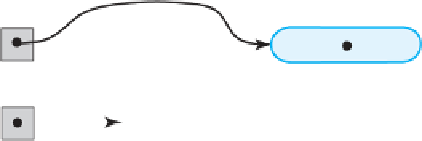Java Reference
In-Depth Information
return
front;
}
// end removeFront
Aside from its name, this method differs from
dequeue
only in the addition of the
else
clause.
Figure 11-19 illustrates the effect of
removeFront
for a deque of at least two entries.
FIGURE 11-19
(a) A deque containing at least two entries; (b) after removing the
first node and obtaining a reference to the deque's new first entry
(a)
firstNode
Entry at front
of deque
(b)
firstNode
Entry at front
of deque
Returned
to client
front
The method
removeBack
has an analogous definition:
public
T removeBack()
{
T back =
null
;
if
(!isEmpty())
{
back = lastNode.getData();
lastNode = lastNode.getPreviousNode();
if
(lastNode ==
null
)
firstNode =
null
;
else
lastNode.setNextNode(
null
);
}
// end if
return
back;
}
// end removeBack
The implementations of
removeFront
and
removeBack
are each O(1).
11.39
Retrieving an entry.
The method
getFront
has the same implementation as given in Segment 11.4
for a queue. The method
getBack
is analogous to
getFront
and is left as an exercise. Both
getFront
and
getBack
are O(1) operations.
Question 8
Implement the method
getBack
for the ADT deque when a doubly linked chain
contains the deque's entries.


































